Animal Awareness Posters
The NIH Animal Awareness Poster Program began in 1989, and is sponsored by the NIH Animal Research Advisory Committee. Please click the images below to access printable versions of past posters.
 Poster 69The 3Rs - ReductionA poster illustrating the concept of reduction using a bar graph.
Poster 69The 3Rs - ReductionA poster illustrating the concept of reduction using a bar graph.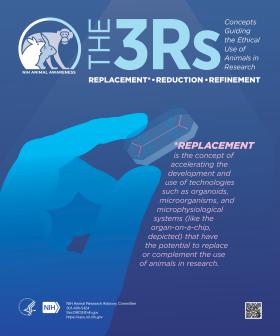 Poster 68The 3Rs - ReplacementThe 3Rs - Concepts Guiding the Ethical Use of Animals in Research. Hand is shown holding an organ-on-a-chip.
Poster 68The 3Rs - ReplacementThe 3Rs - Concepts Guiding the Ethical Use of Animals in Research. Hand is shown holding an organ-on-a-chip. Poster 67Animals are Partners in Reproductive Diseases and Child Health ResearchAnimals are Partners in Reproductive Diseases and Child Health Research
Poster 67Animals are Partners in Reproductive Diseases and Child Health ResearchAnimals are Partners in Reproductive Diseases and Child Health Research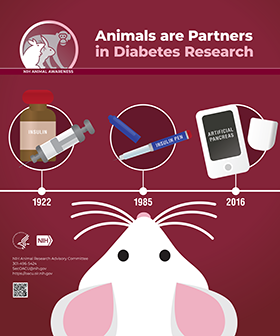 Poster 66Animals are Partners in Diabetes ResearchAnimals are Partners in Diabetes Research
Poster 66Animals are Partners in Diabetes ResearchAnimals are Partners in Diabetes Research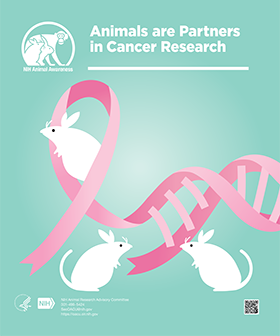 Poster 65Animals are Partners in Cancer ResearchAnimals are Partners in Cancer Research
Poster 65Animals are Partners in Cancer ResearchAnimals are Partners in Cancer Research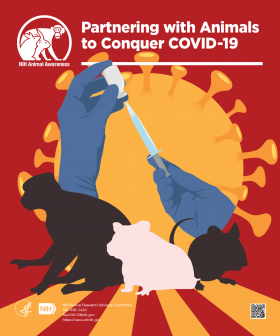 Poster 64Partnering with Animals to Conquer COVID-19Profiles of a nonhuman primate, a hamster, and a mouse are shown overshadowing a coronavirus virus particle. Two gloved hands are also shown with a coronavirus vaccine.
Poster 64Partnering with Animals to Conquer COVID-19Profiles of a nonhuman primate, a hamster, and a mouse are shown overshadowing a coronavirus virus particle. Two gloved hands are also shown with a coronavirus vaccine.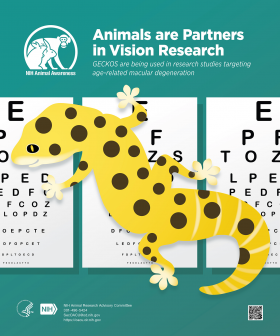 Poster 63Animals are Partners in Vision ResearchA strikingly colored yellow and brown spotted gecko is shown walking over eye vision charts.
Poster 63Animals are Partners in Vision ResearchA strikingly colored yellow and brown spotted gecko is shown walking over eye vision charts.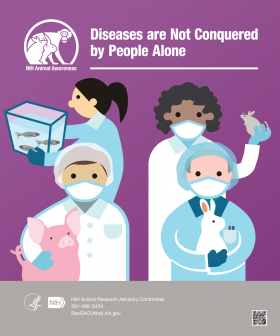 Poster 62Diseases are Not Conquered by People AloneFour different laboratory animal care workers are shown with different laboratory animal species including zebrafish, a mouse, a pig, and a rabbit.
Poster 62Diseases are Not Conquered by People AloneFour different laboratory animal care workers are shown with different laboratory animal species including zebrafish, a mouse, a pig, and a rabbit.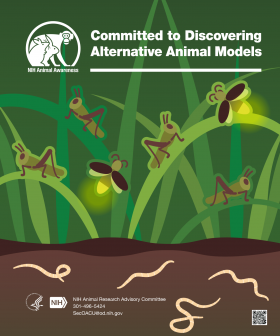 Poster 61Committed to Discovering Alternative Animal ModelsAlternative animal models, including crickets and fireflies are shown on blades of grass. Earthworms are also shown in the ground.
Poster 61Committed to Discovering Alternative Animal ModelsAlternative animal models, including crickets and fireflies are shown on blades of grass. Earthworms are also shown in the ground.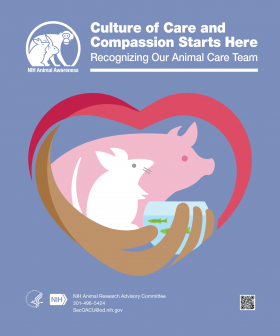 Poster 60Culture of Care and Compassion Starts HereCulture of Care and Compassion Starts Here - Recognizing our animal care team. Image shows a mouse, pig, and fish wrapped in arms that form a heart.
Poster 60Culture of Care and Compassion Starts HereCulture of Care and Compassion Starts Here - Recognizing our animal care team. Image shows a mouse, pig, and fish wrapped in arms that form a heart.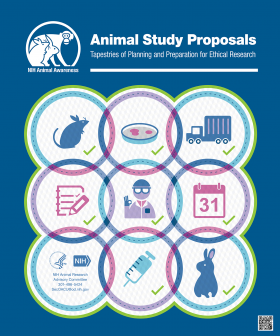 Poster 59Animal Study Proposals – Tapestries of Planning and Preparation for Ethical ResearchThis poster displays 9 overlapping circles that appear to stitched together. In each circle there are symbols that represent requirements of Animal Study Proposals. The symbols include a research animals, transportation truck, lab equipment and administrative supplies.
Poster 59Animal Study Proposals – Tapestries of Planning and Preparation for Ethical ResearchThis poster displays 9 overlapping circles that appear to stitched together. In each circle there are symbols that represent requirements of Animal Study Proposals. The symbols include a research animals, transportation truck, lab equipment and administrative supplies.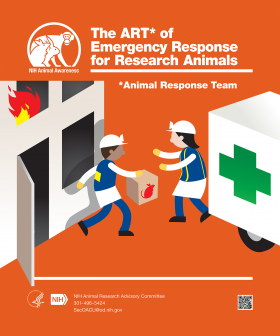 Poster 58The ART* of Emergency Response for Research AnimalsThis poster displays two animal care staff responders with one stepping out of a dark flooded building handing a animal transportation box to the other responder who places it into the back of a truck with a green “safety” cross on the side. The responders are wearing lab coats, protective hats with lamps and vests labeled with the letters ART in reflective letters. At the bottom center of the poster following an “asterisks” are the words “Animal Response Team”.
Poster 58The ART* of Emergency Response for Research AnimalsThis poster displays two animal care staff responders with one stepping out of a dark flooded building handing a animal transportation box to the other responder who places it into the back of a truck with a green “safety” cross on the side. The responders are wearing lab coats, protective hats with lamps and vests labeled with the letters ART in reflective letters. At the bottom center of the poster following an “asterisks” are the words “Animal Response Team”.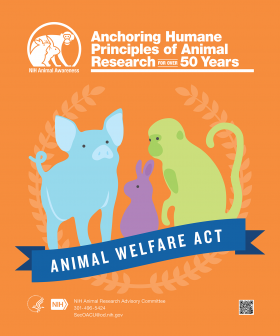 Poster 57Anchoring Humane Principles of Animal Research for over 50 YearsThis poster displays three regulated animal species – a monkey, rabbit and pig. There is a banner at their feet with the words “Animal Welfare Act”. In the background encircling the animals is a laurel wreath watermark.
Poster 57Anchoring Humane Principles of Animal Research for over 50 YearsThis poster displays three regulated animal species – a monkey, rabbit and pig. There is a banner at their feet with the words “Animal Welfare Act”. In the background encircling the animals is a laurel wreath watermark.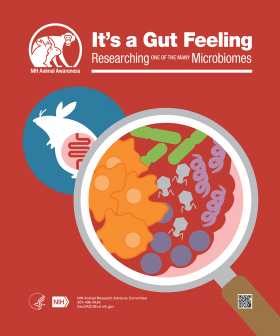 Poster 56It’s a Gut Feeling, Researching One of the Many MicrobiomesThis poster has a burnt orange background with blue circle in the upper left portion of the poster and a large magnifying glass dominating the poster from the bottom right to the center. Inside the circle is the silhouette of a white mouse with another pink circle showing a red stylized digestive tract. The magnifying glass is pointing at the mouse’s gut and shows bacteria, viruses and parasites in orange, green, light blue, light and dark purple.
Poster 56It’s a Gut Feeling, Researching One of the Many MicrobiomesThis poster has a burnt orange background with blue circle in the upper left portion of the poster and a large magnifying glass dominating the poster from the bottom right to the center. Inside the circle is the silhouette of a white mouse with another pink circle showing a red stylized digestive tract. The magnifying glass is pointing at the mouse’s gut and shows bacteria, viruses and parasites in orange, green, light blue, light and dark purple. Poster 55Lecture, Distance Learning, Hands-on, OnlineThis poster has a teal blue background with a honeycomb design as a water mark covering the middle portion of the poster and it shows examples of students using class room, hands on and online remote learning techniques. Directly beneath the title line is an orange rectangle, that goes mostly across the page, with the words “Lecture, Distance Learning, Hands-on, Online”. Underneath those categories, also on the banner, is the URL for the OACU training webpage. At the bottom edge of the rectangle is a group of seated students facing the rectangle with an instructor lecturing them on the right edge of the banner. At the left center of the poster is a male veterinarian and female technician wearing face masks, blue gloves and white lab coats. The technician is holding a mouse as they examine it. At the bottom on the right quadrant of the poster is a seated woman with red hair working on a lap top computer.
Poster 55Lecture, Distance Learning, Hands-on, OnlineThis poster has a teal blue background with a honeycomb design as a water mark covering the middle portion of the poster and it shows examples of students using class room, hands on and online remote learning techniques. Directly beneath the title line is an orange rectangle, that goes mostly across the page, with the words “Lecture, Distance Learning, Hands-on, Online”. Underneath those categories, also on the banner, is the URL for the OACU training webpage. At the bottom edge of the rectangle is a group of seated students facing the rectangle with an instructor lecturing them on the right edge of the banner. At the left center of the poster is a male veterinarian and female technician wearing face masks, blue gloves and white lab coats. The technician is holding a mouse as they examine it. At the bottom on the right quadrant of the poster is a seated woman with red hair working on a lap top computer.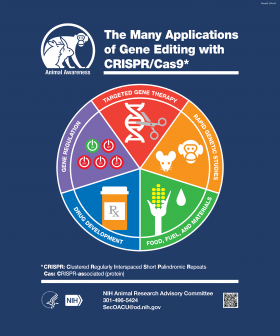 Poster 54The Many Applications of Gene Editing with CRISPR/Cas9*This poster has a dark blue background and a pie shaped graphic with five sections describing the areas of science and commerce that benefit from the use of CRISPR. The top section is red and tilted “Targeted Gene Therapy” with a white double helix being cut by a gray pair of scissors. Progressing clockwise there is an orange section titled “Rapid Genetic Studies” and it shows white cartoon like images of a mouse and monkey faces. The next section is green and titled “Food, Fuel, and Materials”. Within this section are white the silhouettes of a white corn stalk and a yellow cob as well as a drop of water. The next section is royal blue and is titled “Drug Development” and contains an orange prescription bottle with a white RX label. The last section is purple and titled “Gene Regulation”. There are five power buttons with four of them red and labeled “off” and one green one labeled “on”. On the baseline of the poster is the text *CRISPR: Clustered Regularly Interspaced Short Palindromic Repeats; Cas: CRISPR-associated (protein)
Poster 54The Many Applications of Gene Editing with CRISPR/Cas9*This poster has a dark blue background and a pie shaped graphic with five sections describing the areas of science and commerce that benefit from the use of CRISPR. The top section is red and tilted “Targeted Gene Therapy” with a white double helix being cut by a gray pair of scissors. Progressing clockwise there is an orange section titled “Rapid Genetic Studies” and it shows white cartoon like images of a mouse and monkey faces. The next section is green and titled “Food, Fuel, and Materials”. Within this section are white the silhouettes of a white corn stalk and a yellow cob as well as a drop of water. The next section is royal blue and is titled “Drug Development” and contains an orange prescription bottle with a white RX label. The last section is purple and titled “Gene Regulation”. There are five power buttons with four of them red and labeled “off” and one green one labeled “on”. On the baseline of the poster is the text *CRISPR: Clustered Regularly Interspaced Short Palindromic Repeats; Cas: CRISPR-associated (protein)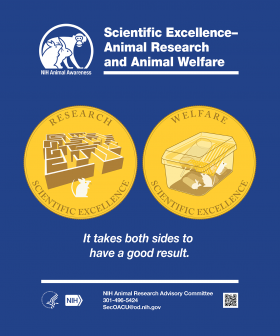 Poster 53Scientific Excellence - Animal Research and Animal WelfareThis poster has a royal blue background and displays two sides of a golden coin placed side by side in the middle of the poster. The coin face on the left has the word “Research” along the top border and “Scientific Excellence” along the bottom border. In the center of this coin is a maze with a white cartoon like mouse looking at the entrance from the lower half of the coin. The coin face on the right has the word “Welfare” along the top border and “Scientific Excellence” along the bottom border. In the center of the poster is the image of a transparent polycarbonate rodent housing container complete with food and water dispensers. There are also three cartoon like mice engaged with enrichment tools to enhance the lives of these socially house housed rodents. Below the coins is the phrase “It takes both sides to have a good result”.
Poster 53Scientific Excellence - Animal Research and Animal WelfareThis poster has a royal blue background and displays two sides of a golden coin placed side by side in the middle of the poster. The coin face on the left has the word “Research” along the top border and “Scientific Excellence” along the bottom border. In the center of this coin is a maze with a white cartoon like mouse looking at the entrance from the lower half of the coin. The coin face on the right has the word “Welfare” along the top border and “Scientific Excellence” along the bottom border. In the center of the poster is the image of a transparent polycarbonate rodent housing container complete with food and water dispensers. There are also three cartoon like mice engaged with enrichment tools to enhance the lives of these socially house housed rodents. Below the coins is the phrase “It takes both sides to have a good result”.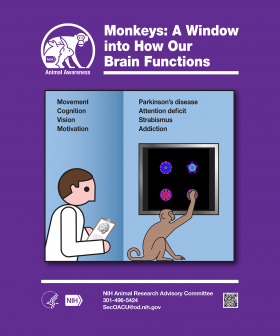 Poster 52Monkeys: A Window into How Our Brain FunctionsThere are two columns of text, which read: Movement - Parkinson’s disease, Cognition - Attention deficit, Vision - Strabismus, and Motivation - Addiction. At the bottom left is a researcher with a clipboard that has a picture of a brain. At the bottom right is a monkey reaching up to a screen with four colored circles.
Poster 52Monkeys: A Window into How Our Brain FunctionsThere are two columns of text, which read: Movement - Parkinson’s disease, Cognition - Attention deficit, Vision - Strabismus, and Motivation - Addiction. At the bottom left is a researcher with a clipboard that has a picture of a brain. At the bottom right is a monkey reaching up to a screen with four colored circles.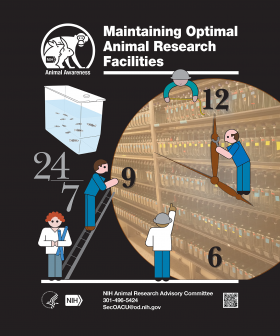 Poster 51Maintaining Optimal Animal Research FacilitiesThis poster has a black background and displays a group of five cartoon like people located around the poster doing building related tasks. The people are dressed in maintenance and construction related clothes and are strategically placed to indicate how they are involved in facility maintenance and construction. A large face of an analog clock is located off center to the right dominates the poster. A picture of aquatic racks containing zebrafish is superimposed on the clock face with the clock hands positioned at 4:00 and the numbers of 12, 6 and 9 correctly located. In the upper left quadrant of the poster is a clear rectangular aquatics container, like the ones in the racks shown on the clock face, with blue water and several zebrafish. Below the aquatics container are the numbers 24/7 and just below them is a female figure wearing a white coat and blue pants with red hair and holding floor plans. To her left is a man dressed in a blue maintenance uniform standing on a ladder leaning on the clock and inspecting the number 9. At the top and bottom of the clock there are two more maintenance workers wearing gray hard hats looking at the number 12 and 6. Lastly, there is a balding worker standing on the hour hand and adjusting the clock with a wrench.
Poster 51Maintaining Optimal Animal Research FacilitiesThis poster has a black background and displays a group of five cartoon like people located around the poster doing building related tasks. The people are dressed in maintenance and construction related clothes and are strategically placed to indicate how they are involved in facility maintenance and construction. A large face of an analog clock is located off center to the right dominates the poster. A picture of aquatic racks containing zebrafish is superimposed on the clock face with the clock hands positioned at 4:00 and the numbers of 12, 6 and 9 correctly located. In the upper left quadrant of the poster is a clear rectangular aquatics container, like the ones in the racks shown on the clock face, with blue water and several zebrafish. Below the aquatics container are the numbers 24/7 and just below them is a female figure wearing a white coat and blue pants with red hair and holding floor plans. To her left is a man dressed in a blue maintenance uniform standing on a ladder leaning on the clock and inspecting the number 9. At the top and bottom of the clock there are two more maintenance workers wearing gray hard hats looking at the number 12 and 6. Lastly, there is a balding worker standing on the hour hand and adjusting the clock with a wrench.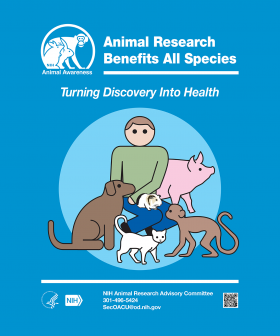 Poster 50Animal Research Benefits All SpeciesThe subtitle at the top of the poster is “Turning Discovery Into Health”. This Caribbean blue colored poster displays a cartoon like male person dressed in casual clothes sitting on the ground in the center of the poster. The person is surrounded by research animals and all of them are superimposed on a light blue circle that encompasses the person and animals. A brown dog is to the left of the person with a white cat in front next to a tan monkey on the right and a pink pig behind and to the right. Lastly, there is a white and black guinea pig on the person’s lap.
Poster 50Animal Research Benefits All SpeciesThe subtitle at the top of the poster is “Turning Discovery Into Health”. This Caribbean blue colored poster displays a cartoon like male person dressed in casual clothes sitting on the ground in the center of the poster. The person is surrounded by research animals and all of them are superimposed on a light blue circle that encompasses the person and animals. A brown dog is to the left of the person with a white cat in front next to a tan monkey on the right and a pink pig behind and to the right. Lastly, there is a white and black guinea pig on the person’s lap.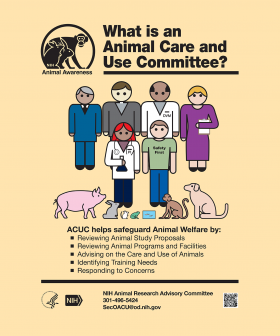 Poster 49What is an Animal Care and Use Committee?This light tan colored poster displays a cartoon like group of six mixed gender people dressed in distinctive work related clothes. It is intended to show the diversity of the “Animal Care and Use Committee”, a requirement for evaluating efficacy of animal study proposals and the use of animals in research. In the middle of the poster is a line of animals looking up at the people. At the bottom of the poster under the title “ACUC helps safeguard Animal Welfare by:” are five bulleted information points explaining why ACUC’s are important for helping maintain good science. The first line of people has a Principal Investigator wearing a lab coat with “PI” below the chest pocket, a stethoscope around her neck and she is holding a beaker. Next to her is a young man in a green tee shirt that has “Safety First” printed on his chest and represents a Safety Officer. In the second row from left to right there is an older man in a blue business suit and represents a non-scientist. Next, is a minister in a gray suit and he has a white clerical collar who represents a non-affiliated community member. Then there is a balding veterinarian in a white lab coat with “DVM” below the chest pocket. The last person is a woman with yellow hair wearing a maroon dress and she is holding a clip board. At the feet of the people and going from left to right the animals are a pink pig, gray rabbit, white mouse, green frog, tank of zebra fish, brown monkey and tan dog. The information points at the bottom of the poster are as follows: “Reviewing Animal Study Proposals, Reviewing Animal Programs and Facilities, Advising on the Care and Use of Animals, Identifying Training Needs and Responding to Concerns”.
Poster 49What is an Animal Care and Use Committee?This light tan colored poster displays a cartoon like group of six mixed gender people dressed in distinctive work related clothes. It is intended to show the diversity of the “Animal Care and Use Committee”, a requirement for evaluating efficacy of animal study proposals and the use of animals in research. In the middle of the poster is a line of animals looking up at the people. At the bottom of the poster under the title “ACUC helps safeguard Animal Welfare by:” are five bulleted information points explaining why ACUC’s are important for helping maintain good science. The first line of people has a Principal Investigator wearing a lab coat with “PI” below the chest pocket, a stethoscope around her neck and she is holding a beaker. Next to her is a young man in a green tee shirt that has “Safety First” printed on his chest and represents a Safety Officer. In the second row from left to right there is an older man in a blue business suit and represents a non-scientist. Next, is a minister in a gray suit and he has a white clerical collar who represents a non-affiliated community member. Then there is a balding veterinarian in a white lab coat with “DVM” below the chest pocket. The last person is a woman with yellow hair wearing a maroon dress and she is holding a clip board. At the feet of the people and going from left to right the animals are a pink pig, gray rabbit, white mouse, green frog, tank of zebra fish, brown monkey and tan dog. The information points at the bottom of the poster are as follows: “Reviewing Animal Study Proposals, Reviewing Animal Programs and Facilities, Advising on the Care and Use of Animals, Identifying Training Needs and Responding to Concerns”.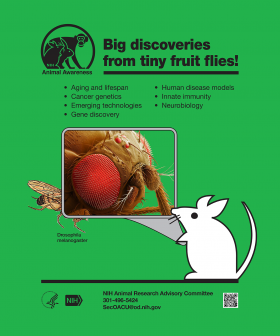 Poster 48Big discoveries from tiny fruit flies!This forest green colored poster displays a white cartoon mouse sitting in the bottom right hand corner of the poster holding a rectangular magnifying glass. There is a tan and black fruit fly labeled “Drosophila melanogaster” on the left side of the poster. The head of the fly is enlarged by the magnifying glass and shows a very detailed image of the red eyes, mouth and assorted hair like appendages on the fly’s head. Above the magnifying glass and directly below the title is a list of health and related technological problems that have and are being studied using the fruit fly as an animal model. The list of topics are; Aging and lifespan, Cancer genetics, Emerging technologies, Gene discovery, Human disease models, Innate immunity and Neurobiology.
Poster 48Big discoveries from tiny fruit flies!This forest green colored poster displays a white cartoon mouse sitting in the bottom right hand corner of the poster holding a rectangular magnifying glass. There is a tan and black fruit fly labeled “Drosophila melanogaster” on the left side of the poster. The head of the fly is enlarged by the magnifying glass and shows a very detailed image of the red eyes, mouth and assorted hair like appendages on the fly’s head. Above the magnifying glass and directly below the title is a list of health and related technological problems that have and are being studied using the fruit fly as an animal model. The list of topics are; Aging and lifespan, Cancer genetics, Emerging technologies, Gene discovery, Human disease models, Innate immunity and Neurobiology.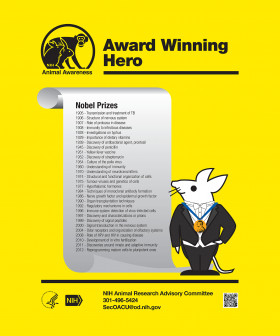 Poster 47Award Winning HeroThis golden yellow colored poster displays a vertically oriented scroll titled “Nobel Prizes” that were earned from 1905 to 2012. This poster consists of thirty one awards for research that was based on animal models. At the bottom right hand corner is a white cartoon mouse standing up and dressed in a black tuxedo with his front leg on his left hip. The golden Noble prize coin on a blue ribbon draped over its neck and he is gazing at the list of awards proudly as a hero might stand. The scroll has two columns. The column on the far left has the dates that the awards were given and the other column has a short description of the achievement for which the award was made. Examples of achievements include; 1945 – Discovery of penicillin, 1990 – Organ transplantation techniques and 2010 – Development of in vitro fertilization.
Poster 47Award Winning HeroThis golden yellow colored poster displays a vertically oriented scroll titled “Nobel Prizes” that were earned from 1905 to 2012. This poster consists of thirty one awards for research that was based on animal models. At the bottom right hand corner is a white cartoon mouse standing up and dressed in a black tuxedo with his front leg on his left hip. The golden Noble prize coin on a blue ribbon draped over its neck and he is gazing at the list of awards proudly as a hero might stand. The scroll has two columns. The column on the far left has the dates that the awards were given and the other column has a short description of the achievement for which the award was made. Examples of achievements include; 1945 – Discovery of penicillin, 1990 – Organ transplantation techniques and 2010 – Development of in vitro fertilization.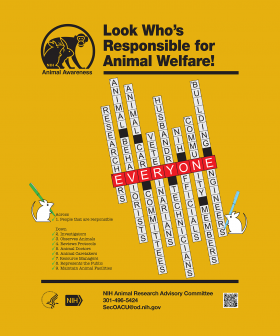 Poster 46Look Who’s Responsible for Animal Welfare!This mustard brown colored poster displays a vertically oriented crossword puzzle that is tilted slightly to the left. This poster consists of nine words or phrases describing the types of people who care for biomedical research animals. At the bottom left hand corner is the list of clues to the puzzle. The only Across clue is the phrase “1. People that are responsible”. “Everyone” is the answer for that clue and is the one word that is written in red boxes horizontally across the poster and it intersects all the Down answers. The Down clues and corresponding answers are: 2. Investigators – Researchers, 3. Observes Animals – Animal Behaviorists, 4. Reviews Protocols – Animal Care Committees, 5. Animal Doctors – Veterinarians, 6. Animal Caretakers – Husbandry Technicians, 7. Resource Managers – NIH Officials, 8. Represents the Public – Community Members, 9. Maintain Animal Facilities – Building Engineers. On the left of the list of clues is a stylized white cartoon mouse holding a green pen and has checked off all the clues. A second cartoon mouse with a blue pen is located on the bottom right side of the poster and is filling in the last letter of the final Down answer.
Poster 46Look Who’s Responsible for Animal Welfare!This mustard brown colored poster displays a vertically oriented crossword puzzle that is tilted slightly to the left. This poster consists of nine words or phrases describing the types of people who care for biomedical research animals. At the bottom left hand corner is the list of clues to the puzzle. The only Across clue is the phrase “1. People that are responsible”. “Everyone” is the answer for that clue and is the one word that is written in red boxes horizontally across the poster and it intersects all the Down answers. The Down clues and corresponding answers are: 2. Investigators – Researchers, 3. Observes Animals – Animal Behaviorists, 4. Reviews Protocols – Animal Care Committees, 5. Animal Doctors – Veterinarians, 6. Animal Caretakers – Husbandry Technicians, 7. Resource Managers – NIH Officials, 8. Represents the Public – Community Members, 9. Maintain Animal Facilities – Building Engineers. On the left of the list of clues is a stylized white cartoon mouse holding a green pen and has checked off all the clues. A second cartoon mouse with a blue pen is located on the bottom right side of the poster and is filling in the last letter of the final Down answer.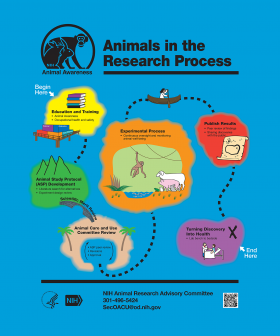 Poster 45Animals in the Research ProcessThis deep ocean blue poster displays an array of islands shown as a stylized treasure map with a cartoon-like female veterinarian canoeing between them as directed by a dotted line. This poster consists of six multi colored islands with each labeled and referring to one of the steps in the research process that involves animals. Each title has one to three bulleted support phrases. Starting in the upper left hand side of the poster is the first island which is yellow and has a “Begin Here” arrow next to it and labeled “Education and Training” with a dock where cargo crates are named “Cancer”, “Diabetes” and “Heart Disease”. The next island is green with mountain peaks and is labeled “Animal Study Protocol Development”. There is a solid stone bridge connecting the second and third islands labeled “Scientific Merit Review”. The third island is labeled “Animal Care and Use Committee”. This tan island has palm trees and a lagoon with arrows to indicate the circulation between the duties of the committee that may need additional reviews to achieve a usable proposal. In the center is the largest island which is orange and labeled “Experimental Process”. There is a frog, mouse, rabbit, pig and sheep gathered next to a pond containing zebra fish. There is also a monkey swinging on vines above them all. On the dotted line going to the next island is the veterinarian canoeing toward a red colored island labeled “Publish Results”. On it is a map of the “Process” on a parchment scroll. The last island located in the bottom right side of the poster is purple and labeled “Turning Discovery into Health”. There is a large “X” with the words “End Here”. On the island is a doctor shaking a bed ridden patient’s hand. The subtitle is, “NIH Animal Care and Use Committee, 301-496-5424.” The OACU and the NIH logos are also shown. In the far bottom right hand corner is a Quick Recovery Code that when scanned by a mobile device will access the OACU webpage.
Poster 45Animals in the Research ProcessThis deep ocean blue poster displays an array of islands shown as a stylized treasure map with a cartoon-like female veterinarian canoeing between them as directed by a dotted line. This poster consists of six multi colored islands with each labeled and referring to one of the steps in the research process that involves animals. Each title has one to three bulleted support phrases. Starting in the upper left hand side of the poster is the first island which is yellow and has a “Begin Here” arrow next to it and labeled “Education and Training” with a dock where cargo crates are named “Cancer”, “Diabetes” and “Heart Disease”. The next island is green with mountain peaks and is labeled “Animal Study Protocol Development”. There is a solid stone bridge connecting the second and third islands labeled “Scientific Merit Review”. The third island is labeled “Animal Care and Use Committee”. This tan island has palm trees and a lagoon with arrows to indicate the circulation between the duties of the committee that may need additional reviews to achieve a usable proposal. In the center is the largest island which is orange and labeled “Experimental Process”. There is a frog, mouse, rabbit, pig and sheep gathered next to a pond containing zebra fish. There is also a monkey swinging on vines above them all. On the dotted line going to the next island is the veterinarian canoeing toward a red colored island labeled “Publish Results”. On it is a map of the “Process” on a parchment scroll. The last island located in the bottom right side of the poster is purple and labeled “Turning Discovery into Health”. There is a large “X” with the words “End Here”. On the island is a doctor shaking a bed ridden patient’s hand. The subtitle is, “NIH Animal Care and Use Committee, 301-496-5424.” The OACU and the NIH logos are also shown. In the far bottom right hand corner is a Quick Recovery Code that when scanned by a mobile device will access the OACU webpage.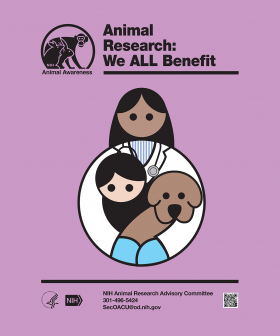 Poster 44Animal Research: We ALL BenefitThis light purple poster displays a stylized cartoon-like female veterinarian with her arms around a child and dog. This simple poster consists of two circles in the center of the poster. A smaller circle representing the veterinarian’s head with long black hair is centered on top of a larger circle representing her body and her arms encircle a boy with black hair and a small brown dog with floppy ears. The veterinarian also has a stethoscope around her neck and is wearing white lab coat and light blue latex gloves. The subtitle is, “NIH Animal Care and Use Committee, 301-496-5424.” The OACU and the NIH logos are also shown. In the far bottom right hand corner is a Quick Recovery Code that when scanned by a mobile device will access the OACU webpage.
Poster 44Animal Research: We ALL BenefitThis light purple poster displays a stylized cartoon-like female veterinarian with her arms around a child and dog. This simple poster consists of two circles in the center of the poster. A smaller circle representing the veterinarian’s head with long black hair is centered on top of a larger circle representing her body and her arms encircle a boy with black hair and a small brown dog with floppy ears. The veterinarian also has a stethoscope around her neck and is wearing white lab coat and light blue latex gloves. The subtitle is, “NIH Animal Care and Use Committee, 301-496-5424.” The OACU and the NIH logos are also shown. In the far bottom right hand corner is a Quick Recovery Code that when scanned by a mobile device will access the OACU webpage.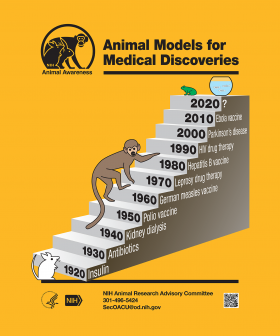 Poster 43Animal Models for Medical DiscoveriesThis burnt orange poster displays a flight of stairs consisting of eleven gray steps. The first step is located at the bottom left side of the poster and rises to the upper right of the poster. There dates in ten year increments labeling each vertical riser starting with 1920 on the bottom step and ending with 2020 on the top riser. On the right side of the staircase each step is labeled with a medical discovery that is associated with each decade. Starting at 1920 with Insulin and continuing with the following discoveries: 1930 - Antibiotics, 1940 - Kidney dialysis, 1950 - Polio vaccine, 1960 - German measles vaccine, 1970 - Leprosy drug therapy, 1980 - Hepatitis B vaccine, 1990 - HIV drug therapy, 2000 - Parkinson’s disease, 2010 - Ebola vaccine and finally a question mark labels the 2020 step. There are also cartoon like animals on the stairs. To the left of the bottom step is a white mouse looking up the stairs. Mid way up the stairs is a brown new world monkey looking out from the poster. On the top stair facing to the left is a green frog and behind him is a fish bowl with blue water containing three small black and white striped fish. The subtitle is, “NIH Animal Care and Use Committee, 301-496-5424.” The OACU and the NIH logos are also shown. In the far bottom right hand corner is a Quick Recovery Code that when scanned by a mobile device will access the OACU webpage.
Poster 43Animal Models for Medical DiscoveriesThis burnt orange poster displays a flight of stairs consisting of eleven gray steps. The first step is located at the bottom left side of the poster and rises to the upper right of the poster. There dates in ten year increments labeling each vertical riser starting with 1920 on the bottom step and ending with 2020 on the top riser. On the right side of the staircase each step is labeled with a medical discovery that is associated with each decade. Starting at 1920 with Insulin and continuing with the following discoveries: 1930 - Antibiotics, 1940 - Kidney dialysis, 1950 - Polio vaccine, 1960 - German measles vaccine, 1970 - Leprosy drug therapy, 1980 - Hepatitis B vaccine, 1990 - HIV drug therapy, 2000 - Parkinson’s disease, 2010 - Ebola vaccine and finally a question mark labels the 2020 step. There are also cartoon like animals on the stairs. To the left of the bottom step is a white mouse looking up the stairs. Mid way up the stairs is a brown new world monkey looking out from the poster. On the top stair facing to the left is a green frog and behind him is a fish bowl with blue water containing three small black and white striped fish. The subtitle is, “NIH Animal Care and Use Committee, 301-496-5424.” The OACU and the NIH logos are also shown. In the far bottom right hand corner is a Quick Recovery Code that when scanned by a mobile device will access the OACU webpage.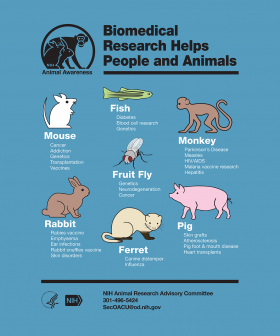 Poster 42Biomedical Research Helps People and AnimalsThis blue-gray poster depicts how integral animals are in the studying of diseases and biomedical advances that have been achieved for both animals and people. There are seven different cartoon-like animals on the poster and each has a list beneath it of diseases and conditions that species has helped study. Proceeding in a clock wise direction at two o’clock is a brown monkey with the following list underneath - Parkinson’s Disease, Measles, HIV/AIDS, Malaria vaccine research and Hepatitis. At four o’clock is a pink pig – Skin grafts, Atherosclerosis, Pig & mouth disease and Heart transplants. At six o’clock is a tan and black footed ferret – Canine distemper and Influenza. At eight o’clock is a brown rabbit – Rabies vaccine, Emphysema, Ear infections, Rabbit snuffles vaccine and Skin disorders. At ten o’clock is a white mouse – Cancer, Addiction, Genetics, Transplantation and Vaccines. At twelve o’clock is a green and black zebrafish – Diabetes, Blood cell research and Genetics. In the center of the poster is a gray and black fruit fly – Genetics, Neurodegeneration and Cancer. The subtitle at the bottom of the poster is NIH Animal Research Advisory Committee, 301-496-5424. The DHHS, NIH and OACU logos are also shown on the poster.
Poster 42Biomedical Research Helps People and AnimalsThis blue-gray poster depicts how integral animals are in the studying of diseases and biomedical advances that have been achieved for both animals and people. There are seven different cartoon-like animals on the poster and each has a list beneath it of diseases and conditions that species has helped study. Proceeding in a clock wise direction at two o’clock is a brown monkey with the following list underneath - Parkinson’s Disease, Measles, HIV/AIDS, Malaria vaccine research and Hepatitis. At four o’clock is a pink pig – Skin grafts, Atherosclerosis, Pig & mouth disease and Heart transplants. At six o’clock is a tan and black footed ferret – Canine distemper and Influenza. At eight o’clock is a brown rabbit – Rabies vaccine, Emphysema, Ear infections, Rabbit snuffles vaccine and Skin disorders. At ten o’clock is a white mouse – Cancer, Addiction, Genetics, Transplantation and Vaccines. At twelve o’clock is a green and black zebrafish – Diabetes, Blood cell research and Genetics. In the center of the poster is a gray and black fruit fly – Genetics, Neurodegeneration and Cancer. The subtitle at the bottom of the poster is NIH Animal Research Advisory Committee, 301-496-5424. The DHHS, NIH and OACU logos are also shown on the poster.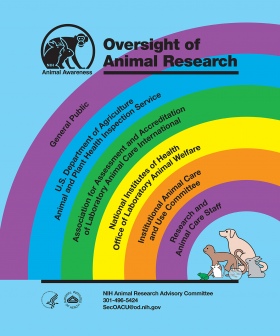 Poster 41Oversight of Animal ResearchThis pale blue poster displays a half of a rainbow ascending from left to right displaying the titles of groups who are involved with the oversight of research animals and under the rainbow is a grouping of animals. The cartoon-like animals are located in the bottom right corner of the poster and are arranged from left to right starting with a green frog, brown monkey, white mouse, a water filled bowl containing gray and black zebrafish, tan dog and a gray rabbit. On the rainbow bands progressing from closest to the animals outward are the following groups and organizations. The first purple band has Research and Animal Staff followed by an orange band with Institutional Animal Care and Use Committee, a yellow band with National Institutes of Health Office of Laboratory Animal Welfare, a green band labeled the Association of Assessment and Accreditation of Laboratory Animal Cane International then a blue band labeled U.S. Department of Agriculture – Animal and Plant Health Inspection Service with the last purple outer band is labeled General Public. The subtitle at the bottom of the poster is NIH Animal Research Advisory Committee, 301-496-5424. The DHHS, NIH and OACU logos are also shown on the poster.
Poster 41Oversight of Animal ResearchThis pale blue poster displays a half of a rainbow ascending from left to right displaying the titles of groups who are involved with the oversight of research animals and under the rainbow is a grouping of animals. The cartoon-like animals are located in the bottom right corner of the poster and are arranged from left to right starting with a green frog, brown monkey, white mouse, a water filled bowl containing gray and black zebrafish, tan dog and a gray rabbit. On the rainbow bands progressing from closest to the animals outward are the following groups and organizations. The first purple band has Research and Animal Staff followed by an orange band with Institutional Animal Care and Use Committee, a yellow band with National Institutes of Health Office of Laboratory Animal Welfare, a green band labeled the Association of Assessment and Accreditation of Laboratory Animal Cane International then a blue band labeled U.S. Department of Agriculture – Animal and Plant Health Inspection Service with the last purple outer band is labeled General Public. The subtitle at the bottom of the poster is NIH Animal Research Advisory Committee, 301-496-5424. The DHHS, NIH and OACU logos are also shown on the poster.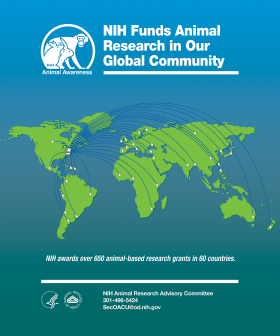 Poster 40NIH Funds Animal Research in Our Global CommunityThis poster is dark green on the bottom half and lightens to a blue green hue at the top of the poster. A light green map of the world shows the countries that receive biomedical grant funds for projects involving research animals. There is a cartoon like white mouse with NIH on its chest located to represent the NIH campus in Bethesda Maryland. Originating from this mouse are a few dozen tracer lines to smaller mice located throughout the world representing countries who receive animal research based grants. Below the map of the world written in white italicized letters is the phrase - NIH awards over 650 animal-based research grants in 60 countries. The subtitle at the bottom of the poster is, A Program Sponsored by The NIH Animal Research Advisory Committee, 301-496-5424. The DHHS, NIH and OACU logos are also shown on the poster.
Poster 40NIH Funds Animal Research in Our Global CommunityThis poster is dark green on the bottom half and lightens to a blue green hue at the top of the poster. A light green map of the world shows the countries that receive biomedical grant funds for projects involving research animals. There is a cartoon like white mouse with NIH on its chest located to represent the NIH campus in Bethesda Maryland. Originating from this mouse are a few dozen tracer lines to smaller mice located throughout the world representing countries who receive animal research based grants. Below the map of the world written in white italicized letters is the phrase - NIH awards over 650 animal-based research grants in 60 countries. The subtitle at the bottom of the poster is, A Program Sponsored by The NIH Animal Research Advisory Committee, 301-496-5424. The DHHS, NIH and OACU logos are also shown on the poster.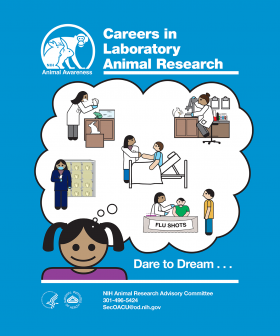 Poster 39Careers in Laboratory Animal ResearchThis royal blue poster displays a young girl with a think bubble displaying five occupations related to lab animal research. The cartoon like girl is wearing a purple dress and has pig tails. She is located in the bottom left of the poster and she is thinking of careers within a bubble above her head. At the top left of the poster a grown up version of the girl and shows her as a veterinarian wearing a face mask and gloves who is examining a mouse with a rabbit, frog and zebra fish in a tank waiting their turn. At the top right she is shown as a bench scientist looking at a microscope with a mouse on the counter top assisting her and holding a check off list. In the center of the poster she is a doctor shaking the hand of a bed ridden patient. At the bottom left she is shown as a member of the animal care staff and is dressed in purple surgical scrubs with a face cover holding a white mouse in front of rack of mouse cages. In the last scene on the bottom right and she is a health care worker giving flu shots made from a vaccine that research animals were essential in developing. At the very bottom of the poster to the right of the girl is the caption Dare to Dream.
Poster 39Careers in Laboratory Animal ResearchThis royal blue poster displays a young girl with a think bubble displaying five occupations related to lab animal research. The cartoon like girl is wearing a purple dress and has pig tails. She is located in the bottom left of the poster and she is thinking of careers within a bubble above her head. At the top left of the poster a grown up version of the girl and shows her as a veterinarian wearing a face mask and gloves who is examining a mouse with a rabbit, frog and zebra fish in a tank waiting their turn. At the top right she is shown as a bench scientist looking at a microscope with a mouse on the counter top assisting her and holding a check off list. In the center of the poster she is a doctor shaking the hand of a bed ridden patient. At the bottom left she is shown as a member of the animal care staff and is dressed in purple surgical scrubs with a face cover holding a white mouse in front of rack of mouse cages. In the last scene on the bottom right and she is a health care worker giving flu shots made from a vaccine that research animals were essential in developing. At the very bottom of the poster to the right of the girl is the caption Dare to Dream.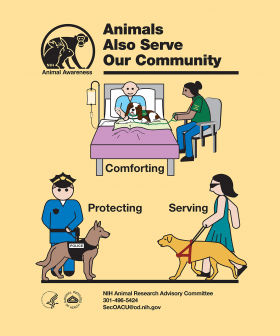 Poster 38Animals Also Serve Our CommunityThis vanilla colored poster displays three scenes of how animals help our community. The first scene at the top center of the poster is of a cartoon like young patient being visited by a brown and white dog in his hospital bed, with the dog’s handler wearing a green shirt and the caption Comforting directly under the bed. The next scene is located on the bottom right of the poster and shows a blind woman in a blue dress being led by yellow service dog with the caption Serving preceding the woman. Lastly, on the bottom left of the poster is a policeman in a blue uniform with a brown dog wearing a vest labeled Police and the caption Protecting above the dog’s head. The subtitle at the bottom of the poster is, A Program Sponsored by The NIH Animal Research Advisory Committee, 301-496-5424. The DHHS, NIH and OACU logos are also shown on the poster.
Poster 38Animals Also Serve Our CommunityThis vanilla colored poster displays three scenes of how animals help our community. The first scene at the top center of the poster is of a cartoon like young patient being visited by a brown and white dog in his hospital bed, with the dog’s handler wearing a green shirt and the caption Comforting directly under the bed. The next scene is located on the bottom right of the poster and shows a blind woman in a blue dress being led by yellow service dog with the caption Serving preceding the woman. Lastly, on the bottom left of the poster is a policeman in a blue uniform with a brown dog wearing a vest labeled Police and the caption Protecting above the dog’s head. The subtitle at the bottom of the poster is, A Program Sponsored by The NIH Animal Research Advisory Committee, 301-496-5424. The DHHS, NIH and OACU logos are also shown on the poster.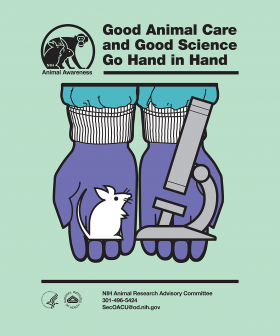 Poster 37Good Animal Care and Good Science Go Hand in HandThis olive green poster displays a pair of purple gloved hands holding a white mouse and gray microscope covering the majority of the poster. The wrists are covered by aqua colored lab coat sleeves with white form fitting cuffs. The palms are facing outward with the mouse in the right had the microscope in the left one. The subtitle is, “A Program Sponsored by The NIH Animal Care and Use Committee, 496-5424.” The OACU and the NIH logos are also shown.
Poster 37Good Animal Care and Good Science Go Hand in HandThis olive green poster displays a pair of purple gloved hands holding a white mouse and gray microscope covering the majority of the poster. The wrists are covered by aqua colored lab coat sleeves with white form fitting cuffs. The palms are facing outward with the mouse in the right had the microscope in the left one. The subtitle is, “A Program Sponsored by The NIH Animal Care and Use Committee, 496-5424.” The OACU and the NIH logos are also shown.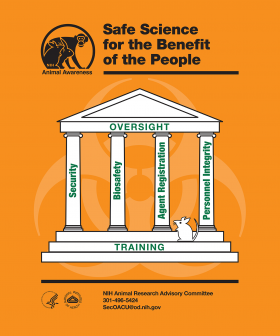 Poster 36Safe Science for the Benefit of the PeopleThis burnt orange poster displays building that resembles the NIH main administration building and has a water mark image of the biohazard symbol over the majority of the poster. It has a classical design with four columns supporting triangular roof and three steps at the base of the building. On the base of the roof’s triangle is the word “Oversight”. The columns are labeled from left to right with the words – “Security”, ”Biosafety”, “Agent Registration” and “Personnel Integrity”. The middle step has the word “Training” and on the right hand side of the poster on the second step is a white mouse looking up at the building. The subtitle is, “A Program Sponsored by The NIH Animal Care and Use Committee, 496-5424.” The OACU and the NIH logos are also shown.
Poster 36Safe Science for the Benefit of the PeopleThis burnt orange poster displays building that resembles the NIH main administration building and has a water mark image of the biohazard symbol over the majority of the poster. It has a classical design with four columns supporting triangular roof and three steps at the base of the building. On the base of the roof’s triangle is the word “Oversight”. The columns are labeled from left to right with the words – “Security”, ”Biosafety”, “Agent Registration” and “Personnel Integrity”. The middle step has the word “Training” and on the right hand side of the poster on the second step is a white mouse looking up at the building. The subtitle is, “A Program Sponsored by The NIH Animal Care and Use Committee, 496-5424.” The OACU and the NIH logos are also shown.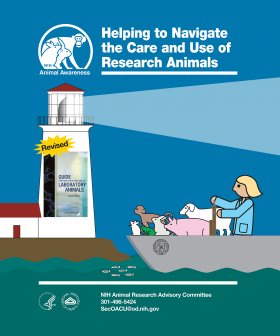 Poster 35Helping Navigate the Care and Use of Research AnimalsThis poster illustrates the importance of the newly revised “Guide for the Care and Use of Laboratory Animals," eighth edition. A light house provides guidance to a boat carrying a scientist and research animals.
Poster 35Helping Navigate the Care and Use of Research AnimalsThis poster illustrates the importance of the newly revised “Guide for the Care and Use of Laboratory Animals," eighth edition. A light house provides guidance to a boat carrying a scientist and research animals.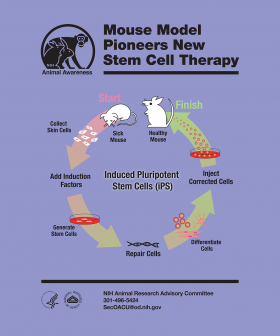 Poster 34Mouse Model Pioneers New Stem Cell TherapyThis poster has a lavender background and shows a circle of treatment with the sequence of steps used in a new form of stem cell therapy starting with a sickly mouse and going full circle to result in a healthy mouse. Progressing in a reverse clockwise manner starting at the eleven o’clock position there is the word “Start” in pink letters and under it is a prostrate white mouse drawn with droopy ears and whiskers and a limp tail. The caption under this mouse in black letters is “Sick Mouse”. The mouse is also superimposed on a thick muted pink arrow pointing from twelve to nine o’clock. At ten o’clock on that arrow several white rectangular cells are shown with the caption “Collect Skin Cells”. At nine o’clock the arrow ends pointing to the words “Add Induction Factors”. A second arrow starts at nine o’clock and progresses to six o’clock and gradationally changes hue from muted pink to light green. At eight o’clock there is a diagram of three yellow cell ovals growing in a red gel filled Petri dish with the caption “Generate Stem Cells”. This arrow head is at the six o’clock position and points to a black double helix with the caption “Repair Cells”. The third arrow starts at six o’clock and points to three o’clock. It changes hue from muted light green gradationally to a brighter light green and points to the caption “Inject Corrected Cells”. At four o’clock there are drawings of dark red muscle, blood and nerve tissues with the caption “Differentiate Cells”. The final arrow starts at three o’clock and goes toward twelve o’clock. It changes from a light green to bright green at the arrow head where it points to a white mouse after treatment with alert eyes, strong tail, erect whiskers and the caption “Healthy Mouse”. Above the mouse is the word “Finish” in bright green letters. At two o’clock there is a Petri dish with red gel and emanating from it are many rows of red and yellow cells filling the arrow proceeding toward the healthy mouse. In the center of the circle of treatment are the words “Induced Pluripotent Stem Cells (IPs) written in black with white shadowing. The subtitle is, “A Program Sponsored by The NIH Animal Care and Use Committee, 496-5424.” The OACU and the NIH logos are also shown.
Poster 34Mouse Model Pioneers New Stem Cell TherapyThis poster has a lavender background and shows a circle of treatment with the sequence of steps used in a new form of stem cell therapy starting with a sickly mouse and going full circle to result in a healthy mouse. Progressing in a reverse clockwise manner starting at the eleven o’clock position there is the word “Start” in pink letters and under it is a prostrate white mouse drawn with droopy ears and whiskers and a limp tail. The caption under this mouse in black letters is “Sick Mouse”. The mouse is also superimposed on a thick muted pink arrow pointing from twelve to nine o’clock. At ten o’clock on that arrow several white rectangular cells are shown with the caption “Collect Skin Cells”. At nine o’clock the arrow ends pointing to the words “Add Induction Factors”. A second arrow starts at nine o’clock and progresses to six o’clock and gradationally changes hue from muted pink to light green. At eight o’clock there is a diagram of three yellow cell ovals growing in a red gel filled Petri dish with the caption “Generate Stem Cells”. This arrow head is at the six o’clock position and points to a black double helix with the caption “Repair Cells”. The third arrow starts at six o’clock and points to three o’clock. It changes hue from muted light green gradationally to a brighter light green and points to the caption “Inject Corrected Cells”. At four o’clock there are drawings of dark red muscle, blood and nerve tissues with the caption “Differentiate Cells”. The final arrow starts at three o’clock and goes toward twelve o’clock. It changes from a light green to bright green at the arrow head where it points to a white mouse after treatment with alert eyes, strong tail, erect whiskers and the caption “Healthy Mouse”. Above the mouse is the word “Finish” in bright green letters. At two o’clock there is a Petri dish with red gel and emanating from it are many rows of red and yellow cells filling the arrow proceeding toward the healthy mouse. In the center of the circle of treatment are the words “Induced Pluripotent Stem Cells (IPs) written in black with white shadowing. The subtitle is, “A Program Sponsored by The NIH Animal Care and Use Committee, 496-5424.” The OACU and the NIH logos are also shown.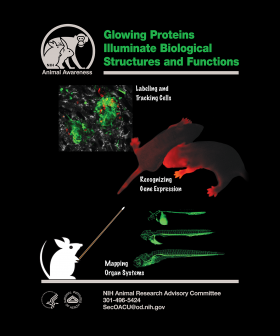 Poster 33Glowing Proteins Illuminate Biological Structures and FunctionsThis poster has a completely black background and depicts how cells, gene expression and internal organ systems of animals can be illuminated using mutated genes that cause proteins to have a florescent glow. At the lower left side of the poster there is a white mouse with a pointer stick being used to draw attention to images that cascade in an arc from the upper left side of the poster to the bottom right in the follow sequence. Starting with a microscope view of block of yellow, red, orange and mostly green cells with the caption in white letters – ”Labeling and Tracking Cells”. The next image if of two neonate rodents that have a shadowy orange outline with solid orange extremities and its caption reads – “Recognizing Gene Expression”. Lastly, in a the lower right side of the poster are three bright green images of a zebra fish showing circulatory, digestive and nervous systems with the caption – “Mapping Organ Systems”. The subtitle is, “A Program Sponsored by The NIH Animal Care and Use Committee, 496-5424.” The OACU and the NIH logos are also shown.
Poster 33Glowing Proteins Illuminate Biological Structures and FunctionsThis poster has a completely black background and depicts how cells, gene expression and internal organ systems of animals can be illuminated using mutated genes that cause proteins to have a florescent glow. At the lower left side of the poster there is a white mouse with a pointer stick being used to draw attention to images that cascade in an arc from the upper left side of the poster to the bottom right in the follow sequence. Starting with a microscope view of block of yellow, red, orange and mostly green cells with the caption in white letters – ”Labeling and Tracking Cells”. The next image if of two neonate rodents that have a shadowy orange outline with solid orange extremities and its caption reads – “Recognizing Gene Expression”. Lastly, in a the lower right side of the poster are three bright green images of a zebra fish showing circulatory, digestive and nervous systems with the caption – “Mapping Organ Systems”. The subtitle is, “A Program Sponsored by The NIH Animal Care and Use Committee, 496-5424.” The OACU and the NIH logos are also shown.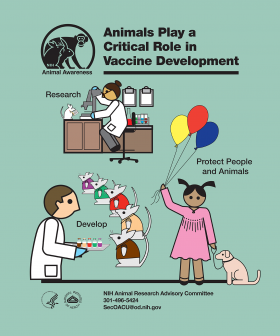 Poster 32Animals Play a Critical Role in Vaccine DevelopmentThis muted aqua-green poster depicts how integral animals are in the vaccine development and the benefits to both animals and people. At the upper left side of the poster there is a female scientist sitting at a lab bench looking into a microscope. There is a small white mouse with a clip board assisting her and above this scene is the word “Research”. Directly underneath the lab scene is a lab technician holding a tray of color coded vials. In front of the technician is a row of white mice wearing colored shirts that correspond with a like colored vial on the tray and in between the mice and technician is the word “Development”. On the lower right side of the poster is little girl in a pink dress holding three balloons and a dog on a leash with the words “Protect People and Animals” above the balloons. The subtitle is, “A Program Sponsored by The NIH Animal Care and Use Committee, 496-5424.” The OACU and the NIH logos are also shown.
Poster 32Animals Play a Critical Role in Vaccine DevelopmentThis muted aqua-green poster depicts how integral animals are in the vaccine development and the benefits to both animals and people. At the upper left side of the poster there is a female scientist sitting at a lab bench looking into a microscope. There is a small white mouse with a clip board assisting her and above this scene is the word “Research”. Directly underneath the lab scene is a lab technician holding a tray of color coded vials. In front of the technician is a row of white mice wearing colored shirts that correspond with a like colored vial on the tray and in between the mice and technician is the word “Development”. On the lower right side of the poster is little girl in a pink dress holding three balloons and a dog on a leash with the words “Protect People and Animals” above the balloons. The subtitle is, “A Program Sponsored by The NIH Animal Care and Use Committee, 496-5424.” The OACU and the NIH logos are also shown. Poster 31Recovering Valuable Live ResourcesThis dark maroon poster depicts how thawed mouse cells can be used to retrieve a mouse strain when recovered embryos are used to impregnate live mice. Moving from the upper left side of the poster and proceeding downward diagonally there is a vial of blue frozen cells by a grouping of nine purple embryos with yellow borders and finally a white mouse nursing three pink pups. Under the vial is the caption “Cryoperserved (Frozen) Cells”. Under the embryos is the caption “Recovered Embryos” and under the mice is written “Recovered Animals”. On the bottom left side is a list of bulleted statements as follows; Reduces Animal Use, Preserves Genetic Integrity and Provides Resources for Future Study through Colony Recovery. The subtitle is, “A Program Sponsored by The NIH Animal Care and Use Committee, 496-5424.” The OACU and the NIH logos are also shown.
Poster 31Recovering Valuable Live ResourcesThis dark maroon poster depicts how thawed mouse cells can be used to retrieve a mouse strain when recovered embryos are used to impregnate live mice. Moving from the upper left side of the poster and proceeding downward diagonally there is a vial of blue frozen cells by a grouping of nine purple embryos with yellow borders and finally a white mouse nursing three pink pups. Under the vial is the caption “Cryoperserved (Frozen) Cells”. Under the embryos is the caption “Recovered Embryos” and under the mice is written “Recovered Animals”. On the bottom left side is a list of bulleted statements as follows; Reduces Animal Use, Preserves Genetic Integrity and Provides Resources for Future Study through Colony Recovery. The subtitle is, “A Program Sponsored by The NIH Animal Care and Use Committee, 496-5424.” The OACU and the NIH logos are also shown.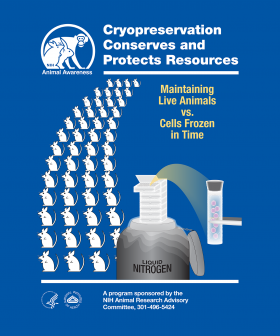 Poster 30Cryopreservation Conserves and Protects ResourcesThis royal blue poster depicts how freezing mouse cell lines can maintain a mouse strain without breeding several generations of mice. On the left side of the poster there are four columns and 13 rows of white mice reducing in size and arcing from the bottom of the poster to the top center representing generations of mice. At the bottom center is an open a gray canister of liquid nitrogen with layers of white fog embracing it and containing white stacked boxes of mouse cell lines emerging from the opening. On the bottom right is a pair of tongs holding a vial of frozen mouse cells that are being removed from the top box. Below the poster title are the words “Maintaining Live Animals vs. Cells Frozen in Time” written in yellow type. The subtitle is, “A Program Sponsored by The NIH Animal Care and Use Committee, 496-5424.” The OACU and the NIH logos are also shown.
Poster 30Cryopreservation Conserves and Protects ResourcesThis royal blue poster depicts how freezing mouse cell lines can maintain a mouse strain without breeding several generations of mice. On the left side of the poster there are four columns and 13 rows of white mice reducing in size and arcing from the bottom of the poster to the top center representing generations of mice. At the bottom center is an open a gray canister of liquid nitrogen with layers of white fog embracing it and containing white stacked boxes of mouse cell lines emerging from the opening. On the bottom right is a pair of tongs holding a vial of frozen mouse cells that are being removed from the top box. Below the poster title are the words “Maintaining Live Animals vs. Cells Frozen in Time” written in yellow type. The subtitle is, “A Program Sponsored by The NIH Animal Care and Use Committee, 496-5424.” The OACU and the NIH logos are also shown.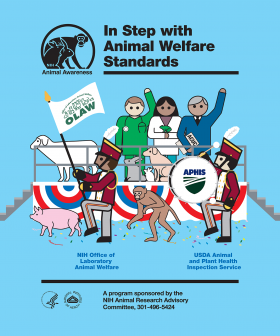 Poster 29In Step with Animal Welfare StandardsThis light blue poster depicts a parade with a marching band being led by a flag bearer followed by drum player in front of a review stand. There are animals and three members of an Animal Care team on the review stand – left to right starting with a white sheep, then a male veterinarian in green scrubs, a female lab technician cradling a green frog and man in a business suit holding a clipboard with the letters ACUC on it. In front of the technician is a gray rabbit, white mouse and tan dog. The parade is being led from the left side of the poster by a pink pig then a the flag bearer with a white flag with a OLAW logo then a brown monkey at the end of the parade is the bass drum player with a APHIS emblem on it. At the bottom is the poster under the flag bearer the acronym OLAW is written out “NIH Office of Laboratory Animal Welfare” and under the drummer “USDA Animal and Plant Health Inspection Service”. The subtitle is, “A Program Sponsored by The NIH Animal Care and Use Committee, 496-5424.” The OACU and the NIH logos are also shown.
Poster 29In Step with Animal Welfare StandardsThis light blue poster depicts a parade with a marching band being led by a flag bearer followed by drum player in front of a review stand. There are animals and three members of an Animal Care team on the review stand – left to right starting with a white sheep, then a male veterinarian in green scrubs, a female lab technician cradling a green frog and man in a business suit holding a clipboard with the letters ACUC on it. In front of the technician is a gray rabbit, white mouse and tan dog. The parade is being led from the left side of the poster by a pink pig then a the flag bearer with a white flag with a OLAW logo then a brown monkey at the end of the parade is the bass drum player with a APHIS emblem on it. At the bottom is the poster under the flag bearer the acronym OLAW is written out “NIH Office of Laboratory Animal Welfare” and under the drummer “USDA Animal and Plant Health Inspection Service”. The subtitle is, “A Program Sponsored by The NIH Animal Care and Use Committee, 496-5424.” The OACU and the NIH logos are also shown.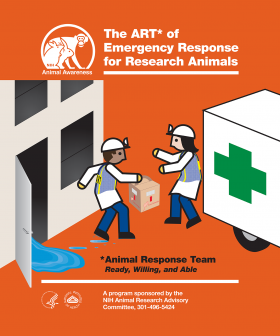 Poster 28The ART* of Emergency ResponseThis burnt orange poster displays two animal care staff with a male responder stepping out of a dark flooded building on the left side of the poster and handing a brown animal transportation box to a female responder. She will take the box and place it into the back of a white truck with a green “safety” cross on the side. The responders are wearing white lab coats, protective hats with lamps and blue vests labeled with the letters ART in reflective yellow letters. At the bottom center of the poster following an “asterisks” are the words “Animal Response Team” and directly underneath them are the italicized words “Ready, Willing and Able”. The subtitle is, “A Program Sponsored by The NIH Animal Care and Use Committee, 496-5424.” The OACU and the NIH logos are also shown.
Poster 28The ART* of Emergency ResponseThis burnt orange poster displays two animal care staff with a male responder stepping out of a dark flooded building on the left side of the poster and handing a brown animal transportation box to a female responder. She will take the box and place it into the back of a white truck with a green “safety” cross on the side. The responders are wearing white lab coats, protective hats with lamps and blue vests labeled with the letters ART in reflective yellow letters. At the bottom center of the poster following an “asterisks” are the words “Animal Response Team” and directly underneath them are the italicized words “Ready, Willing and Able”. The subtitle is, “A Program Sponsored by The NIH Animal Care and Use Committee, 496-5424.” The OACU and the NIH logos are also shown.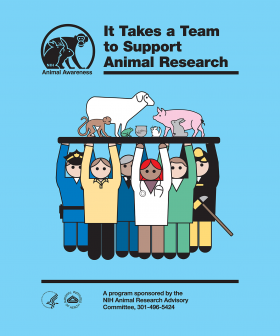 Poster 27It Takes a Team to Support Animal ResearchThis light blue poster displays six multi ethnic mixed gender emergency responders and animal care staff with their arms raised and holding a plank with six different species of research animals on it. The people involved with the total care of the animals are dressed to represent the following groups and are arranged from left to right as follows: policeman, principle investigator, administrator, veterinarian, lab technician and fireman. The animals on the plank are also arranged from left to right starting with a brown monkey, white sheep, green frog, bowl of gray and black zebrafish, white mouse, pink pig and a gray rabbit. The subtitle is, “A Program Sponsored by The NIH Animal Care and Use Committee, 496-5424.” The OACU and the NIH logos are also shown.
Poster 27It Takes a Team to Support Animal ResearchThis light blue poster displays six multi ethnic mixed gender emergency responders and animal care staff with their arms raised and holding a plank with six different species of research animals on it. The people involved with the total care of the animals are dressed to represent the following groups and are arranged from left to right as follows: policeman, principle investigator, administrator, veterinarian, lab technician and fireman. The animals on the plank are also arranged from left to right starting with a brown monkey, white sheep, green frog, bowl of gray and black zebrafish, white mouse, pink pig and a gray rabbit. The subtitle is, “A Program Sponsored by The NIH Animal Care and Use Committee, 496-5424.” The OACU and the NIH logos are also shown.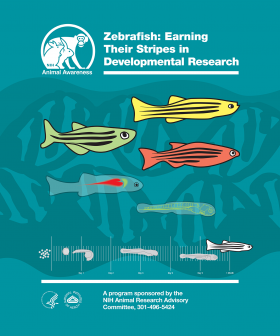 Poster 26Zebrafish: Earning Their Stripes in Developmental ResearchThis light teal green colored poster depicts the life stages of zebrafish and images of genetically altered adult fish used for specialized research. The background of this poster shows two muted dark green strands of DNA drawn to represent seaweed horizontally centered and covering about 75% of the poster. At the bottom of the poster is a time line from 0 to 5 days then jumping to the 30th day. Above the time line fish eggs are shown on the far left followed by four images of a growing fish and ending with a fully developed fish at 1 month old. Above the time line superimposed on the DNA seaweed are five images of fish that were manipulated to emphasize different aspects of the zebrafish. The top three fish are fully developed but are different colors with characteristic black stripes. Below them is a transparent fish with visible stylized internal organs and the last fish is also transparent with a visible skeleton. The subtitle is, “A Program Sponsored by The NIH Animal Care and Use Committee, 496-5424.” The OACU and the NIH logos are also shown.
Poster 26Zebrafish: Earning Their Stripes in Developmental ResearchThis light teal green colored poster depicts the life stages of zebrafish and images of genetically altered adult fish used for specialized research. The background of this poster shows two muted dark green strands of DNA drawn to represent seaweed horizontally centered and covering about 75% of the poster. At the bottom of the poster is a time line from 0 to 5 days then jumping to the 30th day. Above the time line fish eggs are shown on the far left followed by four images of a growing fish and ending with a fully developed fish at 1 month old. Above the time line superimposed on the DNA seaweed are five images of fish that were manipulated to emphasize different aspects of the zebrafish. The top three fish are fully developed but are different colors with characteristic black stripes. Below them is a transparent fish with visible stylized internal organs and the last fish is also transparent with a visible skeleton. The subtitle is, “A Program Sponsored by The NIH Animal Care and Use Committee, 496-5424.” The OACU and the NIH logos are also shown.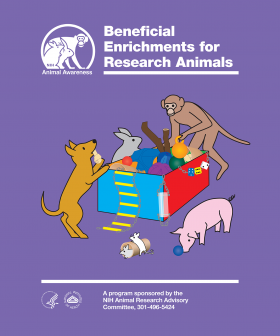 Poster 25Beneficial Enrichments for Research AnimalsThis lavender colored poster depicts five species of animals surrounding a blue and red “toy box” like storage container with each using species specific manipulanda. Proceeding in a clockwise direction at 1:00 there is a brown monkey taking a weighted orange ball out of the box; at 4:00 is a pink pig pushing a blue ball next to the box; at 6:00 there is a gray mouse inside a paper tube with a white mouse climbing on top of the tube; at 8:00 is a dark tan dog with its front paws on the box and chewing a rawhide bone; finally, at 11:00 is a gray rabbit peering over the edge of the box looking at the toys. The subtitle is, “A Program Sponsored by The NIH Animal Care and Use Committee, 496-5424.” The OACU and the NIH logos are also shown.
Poster 25Beneficial Enrichments for Research AnimalsThis lavender colored poster depicts five species of animals surrounding a blue and red “toy box” like storage container with each using species specific manipulanda. Proceeding in a clockwise direction at 1:00 there is a brown monkey taking a weighted orange ball out of the box; at 4:00 is a pink pig pushing a blue ball next to the box; at 6:00 there is a gray mouse inside a paper tube with a white mouse climbing on top of the tube; at 8:00 is a dark tan dog with its front paws on the box and chewing a rawhide bone; finally, at 11:00 is a gray rabbit peering over the edge of the box looking at the toys. The subtitle is, “A Program Sponsored by The NIH Animal Care and Use Committee, 496-5424.” The OACU and the NIH logos are also shown.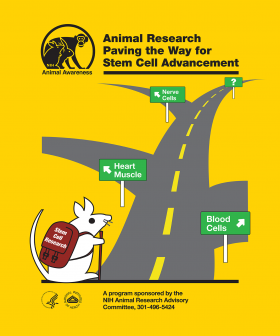 Poster 24Animal Research – Paving the Way for Stem Cell AdvancementThis mustard yellow poster depicts the a mouse with a back pack looking down a road that has three secondary roads branching off it. In the bottom left quadrant is a white mouse with a brown pack labeled “Stem Cell Research” facing the road that leads to the upper right hand quadrant. The first road branches off to the right and is labeled with a green sign that reads “Blood Cells” in white letters. The next road branches left and is labeled “Heart Muscle”. The third road branches left with a “Nerve Cells” sign. The main road continues to the upper right of the poster and has a sign with a question mark on it. The subtitle is, “A Program Sponsored by The NIH Animal Care and Use Committee, 496-5424.” The OACU and the NIH logos are also shown.
Poster 24Animal Research – Paving the Way for Stem Cell AdvancementThis mustard yellow poster depicts the a mouse with a back pack looking down a road that has three secondary roads branching off it. In the bottom left quadrant is a white mouse with a brown pack labeled “Stem Cell Research” facing the road that leads to the upper right hand quadrant. The first road branches off to the right and is labeled with a green sign that reads “Blood Cells” in white letters. The next road branches left and is labeled “Heart Muscle”. The third road branches left with a “Nerve Cells” sign. The main road continues to the upper right of the poster and has a sign with a question mark on it. The subtitle is, “A Program Sponsored by The NIH Animal Care and Use Committee, 496-5424.” The OACU and the NIH logos are also shown.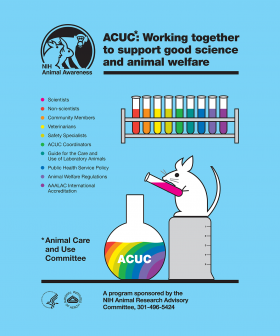 Poster 23ACUC*: Working together to support good science and animal welfareThis light blue poster depicts the diverse members of an Animal Care and Use Committee and associated guides. In the left upper quadrant of the poster is a list of member titles, support documents and organizations with a dot of color to the left of each title. The list includes a red dot for “Scientists” an orange dot with “Non-Scientists”, yellow dot – Veterinarians, mustard dot – Safety Specialists, green dot – ACUC Coordinators, aqua dot – Guide for the Care and Use of Laboratory Animals, blue dot – Public Health Service Policy”, light purple dot – Animal Welfare Regulations, dark purple dot – AAALAC International Accreditation. The upper right quadrant has a rack holding test tubes partially filled with colored liquids matching the list dots. Below the rack is a mouse sitting on an overturned beaker and pouring a tube of red liquid into a bell shaped container that has all the rest of the colors displayed in a rainbow formation inside the container. At the bottom of the poster to the left of the beaker is an asterisk followed by the words “Animal Care and Use Committee”. The subtitle is, “A Program Sponsored by The NIH Animal Care and Use Committee, 496-5424.” The OACU and the NIH logos are also shown.
Poster 23ACUC*: Working together to support good science and animal welfareThis light blue poster depicts the diverse members of an Animal Care and Use Committee and associated guides. In the left upper quadrant of the poster is a list of member titles, support documents and organizations with a dot of color to the left of each title. The list includes a red dot for “Scientists” an orange dot with “Non-Scientists”, yellow dot – Veterinarians, mustard dot – Safety Specialists, green dot – ACUC Coordinators, aqua dot – Guide for the Care and Use of Laboratory Animals, blue dot – Public Health Service Policy”, light purple dot – Animal Welfare Regulations, dark purple dot – AAALAC International Accreditation. The upper right quadrant has a rack holding test tubes partially filled with colored liquids matching the list dots. Below the rack is a mouse sitting on an overturned beaker and pouring a tube of red liquid into a bell shaped container that has all the rest of the colors displayed in a rainbow formation inside the container. At the bottom of the poster to the left of the beaker is an asterisk followed by the words “Animal Care and Use Committee”. The subtitle is, “A Program Sponsored by The NIH Animal Care and Use Committee, 496-5424.” The OACU and the NIH logos are also shown.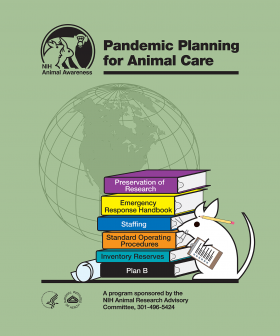 Poster 22Pandemic Planning for Animal CareThis olive green poster displays a large world globe watermark covering most of the poster. At the bottom in the foreground is a stack of different colored binders with their bindings facing out. Each one has a different title using words that represent reasons and topics used for planning that is needed to survive a “Pandemic”. From the top book going down the titles are “Preservation of Research”, “Emergency Response Handbook”, “Staffing”, “Standard Operating Procedures”, “Inventory Reserves” and “Plan B”. To the right of the binders is a white mouse with a pencil perched on its ear and holding a clipboard with a checklist seemingly completing an inventory of the binders. The subtitle is, “A Program Sponsored by The NIH Animal Care and Use Committee, 496-5424.” The OACU and the NIH logos are also shown.
Poster 22Pandemic Planning for Animal CareThis olive green poster displays a large world globe watermark covering most of the poster. At the bottom in the foreground is a stack of different colored binders with their bindings facing out. Each one has a different title using words that represent reasons and topics used for planning that is needed to survive a “Pandemic”. From the top book going down the titles are “Preservation of Research”, “Emergency Response Handbook”, “Staffing”, “Standard Operating Procedures”, “Inventory Reserves” and “Plan B”. To the right of the binders is a white mouse with a pencil perched on its ear and holding a clipboard with a checklist seemingly completing an inventory of the binders. The subtitle is, “A Program Sponsored by The NIH Animal Care and Use Committee, 496-5424.” The OACU and the NIH logos are also shown.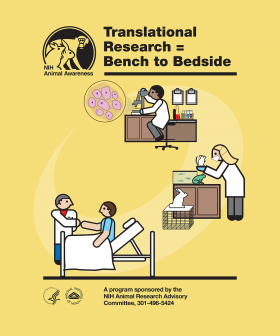 Poster 21Translational Research = Bench to BedsideThis mustard yellow poster depicts the three main stages of “Translation Research”. In the top right quadrant of the poster is a male scientist working over a lab bench peering into a microscope. Seemingly emerging from the microscope stage is an enlarged Petri dish with pink skin cells in it. In the right center portion is a female researcher holding and examining a mouse in her gloved hand. There are also a dog, rabbit and tank full of zebrafish in the lab with the researcher. At the bottom left side of the poster shows a male doctor talking with a patient sitting up in bed shaking his hand. The three scenes are superimposed on an oval water mark to convey that these stages repeat themselves when clinical results lead to new research questions. The subtitle is, “A Program Sponsored by The NIH Animal Care and Use Committee, 496-5424.” The OACU and the NIH logos are also shown.
Poster 21Translational Research = Bench to BedsideThis mustard yellow poster depicts the three main stages of “Translation Research”. In the top right quadrant of the poster is a male scientist working over a lab bench peering into a microscope. Seemingly emerging from the microscope stage is an enlarged Petri dish with pink skin cells in it. In the right center portion is a female researcher holding and examining a mouse in her gloved hand. There are also a dog, rabbit and tank full of zebrafish in the lab with the researcher. At the bottom left side of the poster shows a male doctor talking with a patient sitting up in bed shaking his hand. The three scenes are superimposed on an oval water mark to convey that these stages repeat themselves when clinical results lead to new research questions. The subtitle is, “A Program Sponsored by The NIH Animal Care and Use Committee, 496-5424.” The OACU and the NIH logos are also shown.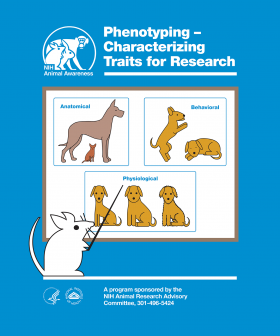 Poster 20Phenotyping – Characterizing Traits ResearchThis light blue poster displays a white mouse on the bottom left hand side of the poster looking up at a chart. The mouse has a long black pointer and is apparently and describing three pictures on the chart. The pictures are used to describe the labels outwardly observable or phenotypical traits. On the upper left side of the poster the word in bold face is “Anatomical” and shows a large dog standing up with a small dog underneath. On the upper right side is the word “Behavioral”were there are two brown same species scruffy looking dogs. The one on the left energetically walking on its back feet, tail wagging, mouth agape and ears erect. The other dog on the right side is listless and appears to be sleeping. The third picture is titled “Physiological” and shows a trio of same species dog. However the one on the left is slender, the middle one is heavy set and on the right has rough fur and a medium size. The subtitle is, “A Program Sponsored by The NIH Animal Care and Use Committee, 496-5424.” The OACU and the NIH logos are also shown.
Poster 20Phenotyping – Characterizing Traits ResearchThis light blue poster displays a white mouse on the bottom left hand side of the poster looking up at a chart. The mouse has a long black pointer and is apparently and describing three pictures on the chart. The pictures are used to describe the labels outwardly observable or phenotypical traits. On the upper left side of the poster the word in bold face is “Anatomical” and shows a large dog standing up with a small dog underneath. On the upper right side is the word “Behavioral”were there are two brown same species scruffy looking dogs. The one on the left energetically walking on its back feet, tail wagging, mouth agape and ears erect. The other dog on the right side is listless and appears to be sleeping. The third picture is titled “Physiological” and shows a trio of same species dog. However the one on the left is slender, the middle one is heavy set and on the right has rough fur and a medium size. The subtitle is, “A Program Sponsored by The NIH Animal Care and Use Committee, 496-5424.” The OACU and the NIH logos are also shown. Poster 19Recognizing Humane Principles of Animal ResearchThis aqua blue poster displays three multi ethnic mixed gender animal care staff on the bottom left hand side of the poster looking up at an award in the center. Opposite them on the bottom right side are right are monkey, rabbit, mouse, and a frog, seemingly reading the award. The award is a wooden and brass plaque that is inscribed with “45th Anniversary of “The Principles of Humane Experimental Technique*””. Under the inscription are the words “Reduction, Refinement, Replacement” which describe the basic tenants of the “Principles”. At the bottom of the poster the asterisks is described with - * Russell, W.M.S. & Burch, R.L. (1959) The Principles of Humane Experimentation Technique, London, U.K: Methuen. The subtitle is, “A Program Sponsored by The NIH Animal Care and Use Committee, 496-5424.” The OACU and the NIH logos are also shown.
Poster 19Recognizing Humane Principles of Animal ResearchThis aqua blue poster displays three multi ethnic mixed gender animal care staff on the bottom left hand side of the poster looking up at an award in the center. Opposite them on the bottom right side are right are monkey, rabbit, mouse, and a frog, seemingly reading the award. The award is a wooden and brass plaque that is inscribed with “45th Anniversary of “The Principles of Humane Experimental Technique*””. Under the inscription are the words “Reduction, Refinement, Replacement” which describe the basic tenants of the “Principles”. At the bottom of the poster the asterisks is described with - * Russell, W.M.S. & Burch, R.L. (1959) The Principles of Humane Experimentation Technique, London, U.K: Methuen. The subtitle is, “A Program Sponsored by The NIH Animal Care and Use Committee, 496-5424.” The OACU and the NIH logos are also shown.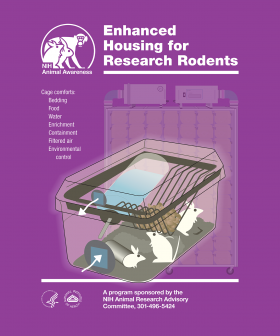 Poster 18Enhanced Housing for Research RodentsThis light purple poster displays three white mice in a micro-isolator cage. The cage is equipped with a water bottle, food dispensing wire shelf and bedding material. The cage drawing is superimposed over a faded image of a cage rack holding many columns of similar cages. On the upper left hand quadrant of the cage there is a list entitled “Cage Comforts” describing the benefits provided by the cage. They are “Bedding, Food, Water, Enrichment, Containment, Filtered Air and Environmental Control”. The subtitle is, “A Program Sponsored by The NIH Animal Care and Use Committee, 496-5424.” The OACU and the NIH logos are also shown.
Poster 18Enhanced Housing for Research RodentsThis light purple poster displays three white mice in a micro-isolator cage. The cage is equipped with a water bottle, food dispensing wire shelf and bedding material. The cage drawing is superimposed over a faded image of a cage rack holding many columns of similar cages. On the upper left hand quadrant of the cage there is a list entitled “Cage Comforts” describing the benefits provided by the cage. They are “Bedding, Food, Water, Enrichment, Containment, Filtered Air and Environmental Control”. The subtitle is, “A Program Sponsored by The NIH Animal Care and Use Committee, 496-5424.” The OACU and the NIH logos are also shown.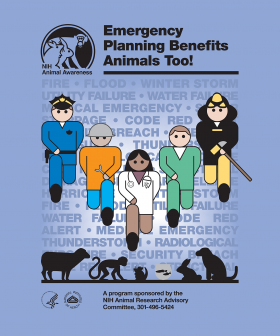 Poster 17Emergency Planning Benefits Animals TooThis periwinkle blue poster displays five multi ethnic mixed gender emergency responders and animal care staff running in a phalanx toward the bottom of the poster. The responders are superimposed over a list of emergency description phrases including “Fire, Flood and Winter Storm”. At the bottom of the poster from left to right are the silhouettes of a sheep, monkey, mouse, bowl of zebrafish, rabbit and a dog, seemingly attending to the group of rescue workers. The subtitle is, “A Program Sponsored by The NIH Animal Care and Use Committee, 496-5424.” The OACU and the NIH logos are also shown.
Poster 17Emergency Planning Benefits Animals TooThis periwinkle blue poster displays five multi ethnic mixed gender emergency responders and animal care staff running in a phalanx toward the bottom of the poster. The responders are superimposed over a list of emergency description phrases including “Fire, Flood and Winter Storm”. At the bottom of the poster from left to right are the silhouettes of a sheep, monkey, mouse, bowl of zebrafish, rabbit and a dog, seemingly attending to the group of rescue workers. The subtitle is, “A Program Sponsored by The NIH Animal Care and Use Committee, 496-5424.” The OACU and the NIH logos are also shown. Poster 16Enrichment CountsThis olive green poster displays a large non-human primate enclosure with the walls shown by gradationally different shades of green rather than bars or plexiglass panels. Within the enclosure eight monkeys are engaged in species specific enrichment activities. The activities include using a foraging board, grooming each other, swinging from white plastic piping at the top of the cage and using a mirror that is tethered to the outside of the enclosure. At the bottom in the foreground is a monkey walking to the left side of the enclosure where a caregiver in complete personal protective equipment is depositing bananas through an escape proof pass through window. The subtitle is, “A Program Sponsored by The NIH Animal Care and Use Committee, 496-5424.” The OACU and the NIH logos are also shown.
Poster 16Enrichment CountsThis olive green poster displays a large non-human primate enclosure with the walls shown by gradationally different shades of green rather than bars or plexiglass panels. Within the enclosure eight monkeys are engaged in species specific enrichment activities. The activities include using a foraging board, grooming each other, swinging from white plastic piping at the top of the cage and using a mirror that is tethered to the outside of the enclosure. At the bottom in the foreground is a monkey walking to the left side of the enclosure where a caregiver in complete personal protective equipment is depositing bananas through an escape proof pass through window. The subtitle is, “A Program Sponsored by The NIH Animal Care and Use Committee, 496-5424.” The OACU and the NIH logos are also shown.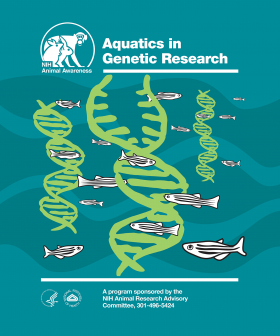 Poster 15Aquatics in Genetic ResearchThis poster displays bands of teal and green horizontally undulating across the poster. There are three light green DNA strands of various sizes vertically located on the poster to represent a kelp bed. Swimming around the strands are 16 black and white zebrafish of various sizes. The size variations are used for depth depending on the relative positions from the viewer. The subtitle is, “A Program Sponsored by The NIH Animal Care and Use Committee, 496-5424.” The OACU and the NIH logos are also shown.
Poster 15Aquatics in Genetic ResearchThis poster displays bands of teal and green horizontally undulating across the poster. There are three light green DNA strands of various sizes vertically located on the poster to represent a kelp bed. Swimming around the strands are 16 black and white zebrafish of various sizes. The size variations are used for depth depending on the relative positions from the viewer. The subtitle is, “A Program Sponsored by The NIH Animal Care and Use Committee, 496-5424.” The OACU and the NIH logos are also shown.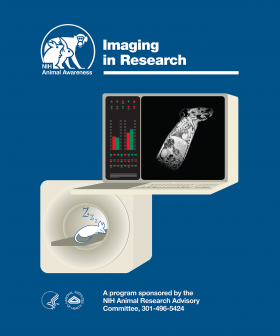 Poster 14Imaging ResearchThis royal blue poster displays a monitor screen on the top right of the poster with the left half showing polychromatic columns and an MRI image of the cross section of a mouse on the right side. On the bottom left side of the poster is an MRI machine with a mouse sleeping inside of it being scanned. The subtitle is, “A Program Sponsored by The NIH Animal Care and Use Committee, 496-5424.” The OACU and the NIH logos are also shown.
Poster 14Imaging ResearchThis royal blue poster displays a monitor screen on the top right of the poster with the left half showing polychromatic columns and an MRI image of the cross section of a mouse on the right side. On the bottom left side of the poster is an MRI machine with a mouse sleeping inside of it being scanned. The subtitle is, “A Program Sponsored by The NIH Animal Care and Use Committee, 496-5424.” The OACU and the NIH logos are also shown.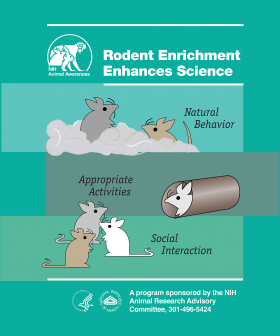 Poster 13Rodent Enrichment Enhances ScienceThis emerald green poster displays a vertical rectangle divided into three horizontal bands of different shades of green. The top band has a brown and gray mouse manipulating nesting material with the words “Natural Behavior”. The middle band has a singular white mouse inside a paper tube with the words “Appropriate Activities”. The bottom band has a brown, gray and white mouse sitting and facing each other with the phrase “Social Interaction”. The subtitle is, “A Program Sponsored by The NIH Animal Care and Use Committee, 496-5424.” The OACU and the NIH logos are also shown.
Poster 13Rodent Enrichment Enhances ScienceThis emerald green poster displays a vertical rectangle divided into three horizontal bands of different shades of green. The top band has a brown and gray mouse manipulating nesting material with the words “Natural Behavior”. The middle band has a singular white mouse inside a paper tube with the words “Appropriate Activities”. The bottom band has a brown, gray and white mouse sitting and facing each other with the phrase “Social Interaction”. The subtitle is, “A Program Sponsored by The NIH Animal Care and Use Committee, 496-5424.” The OACU and the NIH logos are also shown.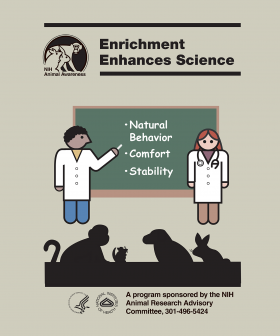 Poster 12Enrichment Enhances ScienceThis light gray poster shows a classroom black board with the phrases listed in bullet form down the board. The phrases are “Natural Behavior”, “Comfort” and “Stability”. There is a scientist with chalk in his hand on the left side of the board pointing at the list and a female scientist on the right side looking out at an audience of animals. At the bottom of the poster from left to right are the silhouettes of a monkey, mouse, dog and rabbit seemingly attending to the speaker. The subtitle is, “A Program Sponsored by The NIH Animal Care and Use Committee, 496-5424.” The OACU and the NIH logos are also shown.
Poster 12Enrichment Enhances ScienceThis light gray poster shows a classroom black board with the phrases listed in bullet form down the board. The phrases are “Natural Behavior”, “Comfort” and “Stability”. There is a scientist with chalk in his hand on the left side of the board pointing at the list and a female scientist on the right side looking out at an audience of animals. At the bottom of the poster from left to right are the silhouettes of a monkey, mouse, dog and rabbit seemingly attending to the speaker. The subtitle is, “A Program Sponsored by The NIH Animal Care and Use Committee, 496-5424.” The OACU and the NIH logos are also shown.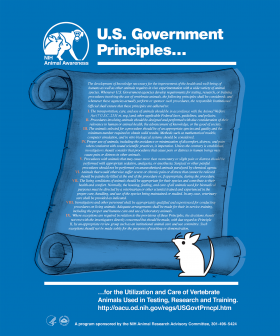 Poster 11U.S. Government Principles…This royal blue poster features a scroll of parchment paper inscribed with the nine guiding principles which provide the basis for how vertebrate animals are used in biomedical research. There is a mouse at the bottom of the unfurled document looking up and reading it. At the bottom of the poster the rest of the sentence started in the title reads “…for the Utilization and Care of Vertebrate Animals Used in Testing, Research and Training.” The subtitle is, “A Program Sponsored by The NIH Animal Care and Use Committee, 496-5424.” The OACU and the NIH logos are also shown.
Poster 11U.S. Government Principles…This royal blue poster features a scroll of parchment paper inscribed with the nine guiding principles which provide the basis for how vertebrate animals are used in biomedical research. There is a mouse at the bottom of the unfurled document looking up and reading it. At the bottom of the poster the rest of the sentence started in the title reads “…for the Utilization and Care of Vertebrate Animals Used in Testing, Research and Training.” The subtitle is, “A Program Sponsored by The NIH Animal Care and Use Committee, 496-5424.” The OACU and the NIH logos are also shown.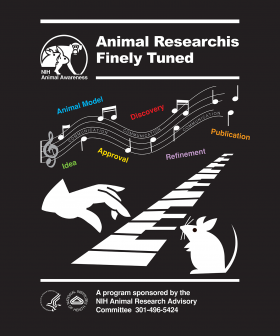 Poster 10Animal Research is Finely TunedThis black colored poster shows a white gloved hand on the left side of the poster playing a piano keyboard. Above the hand is a flowing line of music with the word “Communication” between the note lines. Starting on the left side of alternating below and above the line of music are the words “Idea, Animal Proposal, Approval, Discovery, Refinement and Publication”. There is a stylized white mouse in the bottom right hand corner listening to the music. The subtitle is, “A Program Sponsored by The NIH Animal Care and Use Committee, 496-5424.” The OACU and the NIH logos are also shown.
Poster 10Animal Research is Finely TunedThis black colored poster shows a white gloved hand on the left side of the poster playing a piano keyboard. Above the hand is a flowing line of music with the word “Communication” between the note lines. Starting on the left side of alternating below and above the line of music are the words “Idea, Animal Proposal, Approval, Discovery, Refinement and Publication”. There is a stylized white mouse in the bottom right hand corner listening to the music. The subtitle is, “A Program Sponsored by The NIH Animal Care and Use Committee, 496-5424.” The OACU and the NIH logos are also shown.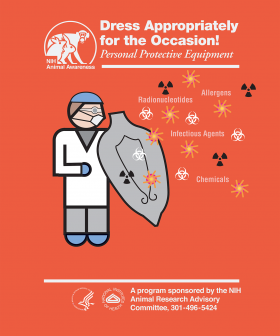 Poster 9Dress Appropriately for the Occasion – Personal Protective EquipmentThis orange colored poster shows an animal care technician on the left side of the poster wearing head covering, goggles, gloves, face mask, shoe covers and a lab coat. The technician is holding a shield warding off symbols of hazardous agents. The agents are labeled “Radionucleotides, Chemicals, Allergens and Infectious Agents”. The subtitle is, “A Program Sponsored by The NIH Animal Care and Use Committee, 496-5424.” The OACU and the NIH logos are also shown.
Poster 9Dress Appropriately for the Occasion – Personal Protective EquipmentThis orange colored poster shows an animal care technician on the left side of the poster wearing head covering, goggles, gloves, face mask, shoe covers and a lab coat. The technician is holding a shield warding off symbols of hazardous agents. The agents are labeled “Radionucleotides, Chemicals, Allergens and Infectious Agents”. The subtitle is, “A Program Sponsored by The NIH Animal Care and Use Committee, 496-5424.” The OACU and the NIH logos are also shown.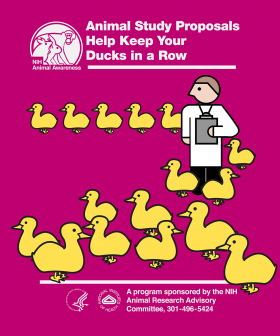 Poster 8Animal Study Proposals Help Keep Your Ducks in a RowThis fuchsia colored poster shows a scientist with a clipboard observing an orderly line of yellow ducks at the bottom of the poster. Behind the scientist there are several disorganized ducks. The subtitle is, “A Program Sponsored by The NIH Animal Care and Use Committee, 496-5424.” The OACU and the NIH logos are also shown.
Poster 8Animal Study Proposals Help Keep Your Ducks in a RowThis fuchsia colored poster shows a scientist with a clipboard observing an orderly line of yellow ducks at the bottom of the poster. Behind the scientist there are several disorganized ducks. The subtitle is, “A Program Sponsored by The NIH Animal Care and Use Committee, 496-5424.” The OACU and the NIH logos are also shown.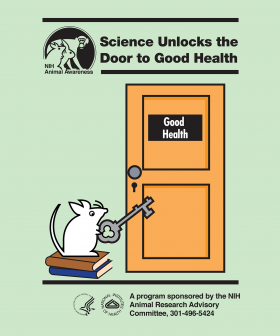 Poster 7Science Unlocks the Door to Good HealthThis pale green poster shows a white stylized mouse atop a pile of reference books holding a large old fashion key. The mouse is directing the key to a large orange door that is labeled “Good Health”. The subtitle is, “A Program Sponsored by The NIH Animal Care and Use Committee, 496-5424.” The OACU and the NIH logos are also shown.
Poster 7Science Unlocks the Door to Good HealthThis pale green poster shows a white stylized mouse atop a pile of reference books holding a large old fashion key. The mouse is directing the key to a large orange door that is labeled “Good Health”. The subtitle is, “A Program Sponsored by The NIH Animal Care and Use Committee, 496-5424.” The OACU and the NIH logos are also shown.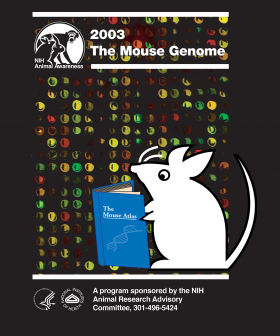 Poster 62003 The Mouse GenomeThis black poster shows a polychromatic array including yellow, green and red dots in the background. At the bottom of the poster a wide eyed white stylized mouse facing the left side of the poster and is reading a book with a double helix on the cover entitled “The Mouse Atlas”. The subtitle is, “A Program Sponsored by The NIH Animal Care and Use Committee, 496-5424.” The OACU and the NIH logos are also shown.
Poster 62003 The Mouse GenomeThis black poster shows a polychromatic array including yellow, green and red dots in the background. At the bottom of the poster a wide eyed white stylized mouse facing the left side of the poster and is reading a book with a double helix on the cover entitled “The Mouse Atlas”. The subtitle is, “A Program Sponsored by The NIH Animal Care and Use Committee, 496-5424.” The OACU and the NIH logos are also shown.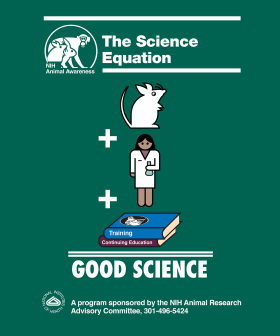 Poster 5The Science EquationThis olive green poster shows a vertical addition problem with a mouse at the top then a plus sign followed a female scientist then another plus sign with two books labeled “Training” and “Continuing Education” at the bottom of the equation. Under the summation line are the words “Good Science”. The subtitle is, “A Program Sponsored by The NIH Animal Care and Use Committee, 496-5424.” The OACU and the NIH logos are also shown.
Poster 5The Science EquationThis olive green poster shows a vertical addition problem with a mouse at the top then a plus sign followed a female scientist then another plus sign with two books labeled “Training” and “Continuing Education” at the bottom of the equation. Under the summation line are the words “Good Science”. The subtitle is, “A Program Sponsored by The NIH Animal Care and Use Committee, 496-5424.” The OACU and the NIH logos are also shown.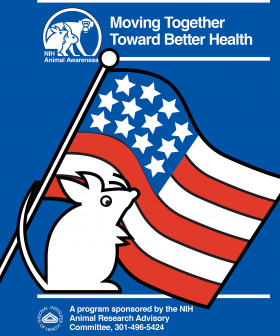 Poster 4Advancing Together Toward Better HealthThis royal blue poster has a large American flag unfurled from left to right with a large hand drawn white rodent below the flag facing the right side of the poster. The subtitle is, “A Program Sponsored by The NIH Animal Care and Use Committee, 496-5424.” The OACU and the NIH logos are also shown.
Poster 4Advancing Together Toward Better HealthThis royal blue poster has a large American flag unfurled from left to right with a large hand drawn white rodent below the flag facing the right side of the poster. The subtitle is, “A Program Sponsored by The NIH Animal Care and Use Committee, 496-5424.” The OACU and the NIH logos are also shown.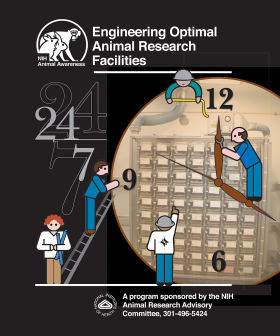 Poster 3Engineering Optimal Animal Research FacilitiesThis black poster has a large analog clock with rack of rodent cages superimposed on the face. There are five maintenance and engineering related multi ethnic mixed gender staff dressed in their daily work clothes performing various duties related to keeping the cages functioning properly. The subtitle is, “A Program Sponsored by The NIH Animal Care and Use Committee, 496-5424.” The OACU and the NIH logos are also shown.
Poster 3Engineering Optimal Animal Research FacilitiesThis black poster has a large analog clock with rack of rodent cages superimposed on the face. There are five maintenance and engineering related multi ethnic mixed gender staff dressed in their daily work clothes performing various duties related to keeping the cages functioning properly. The subtitle is, “A Program Sponsored by The NIH Animal Care and Use Committee, 496-5424.” The OACU and the NIH logos are also shown.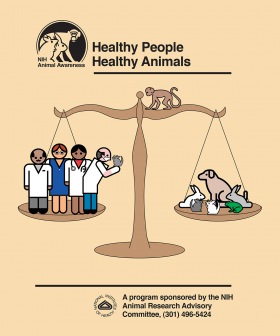 Poster 2Healthy People – Healthy AnimalsAn old fashion balance scale as the focal point. There are four animal research on the left scale dish. In the right dish are six multi species animals. At the top of the scale from right to left is a monkey.
Poster 2Healthy People – Healthy AnimalsAn old fashion balance scale as the focal point. There are four animal research on the left scale dish. In the right dish are six multi species animals. At the top of the scale from right to left is a monkey.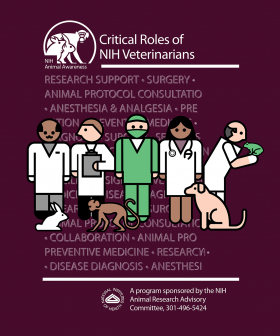 Poster 1Critical Roles of NIH VeterinariansThis poster has veterinarians in work-related outfits in a line horizontally across the poster. Behind them is a list of all the duties and activities they perform as veterinarians. Some of the activities are research support and preventive Medicine.
Poster 1Critical Roles of NIH VeterinariansThis poster has veterinarians in work-related outfits in a line horizontally across the poster. Behind them is a list of all the duties and activities they perform as veterinarians. Some of the activities are research support and preventive Medicine.
This page was last updated on Tuesday, June 10, 2025